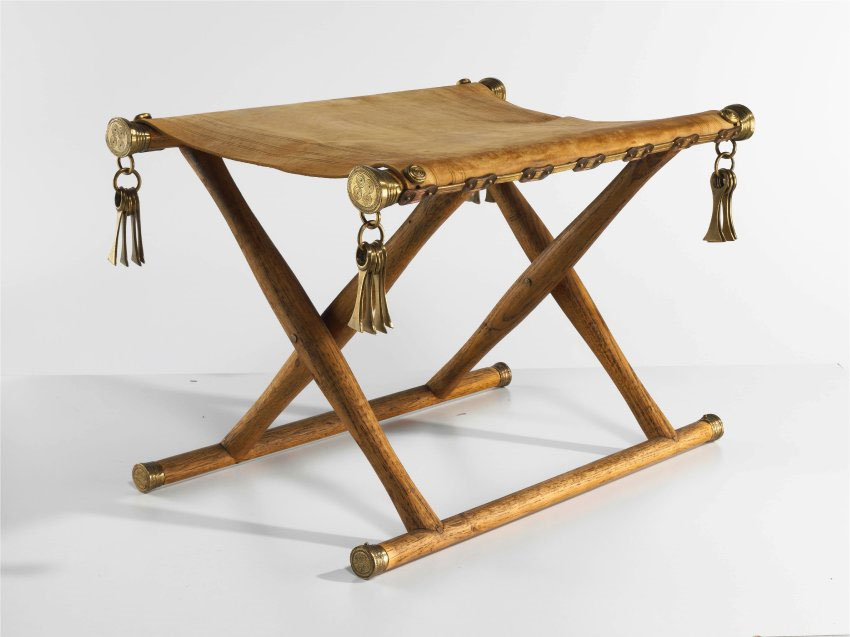Pharaoh's chairs sit copyrighted
Nearly 3,500 years ago, the folding chairs that Pharaoh in Egypt used to sit were indispensable in many parts of Northern Europe. Now, scholars think this may be an ancient industrial espionage.
When Tutankhamen died, his grave was filled with precious objects, including two folding chairs, an ivory made of ivory ebony. These sophisticated chairs were used in Egypt more than 4,000 years ago. The surprisingly simple design consists of two mobile wooden frames connected by safety pins and a stretch of animal skin above.
This is not surprising, because at that time, the Egyptians were very familiar with that comfortable chair. However, the surprising thing is that the rude heads of Northern Europe also use that kind of chair. So far, 20 similar seats have been found in Northern Europe, mostly in the northern part of Germany's Elbe River. Most of the seats found were rotted, leaving only rivets and brass or gold pins.

The chair from the Bronze Age is being stored in a museum in Germany.
The only intact chair was found in 1891 in the Golden Hill, near the Jutland peninsula, part of present-day Denmark. The chair dates back to 1389. It is made from ash wood, covered with otter skin found in a coffin made from stems.
But this type of folding chair is obviously from the East. The oldest picture of this wood was found on the 4,500-year-old seal of Mesopotamia. Egyptians were used to using this type of chair in the earlier period.
The use of such a chair design in Northern Europe led scholars to assume that Nordic people thought of the structure independently and in parallel with the Egyptians. But that view is now rejected, because the design and size of the chairs are too similar. Now, scholars argue that Nordic people stole this design. Perhaps the Egyptians and Northern Europeans were interrelated since 3,400 years ago.
Perhaps a commercial network was formed during the Bronze Age, at that time, luxury items were exchanged between the two areas thanks to pedestrians.
This type of folding chair has been transmitted from one tribe to another, from one region to another. However, the strange thing is that folding chairs are only used in Egypt and Northern Europe but are not used in the junction between the two areas. Therefore, it is hypothesized that Northern merchants had a long journey from the Baltic Sea to Egypt, they stole this design and brought it to the North.
Scholars also determine the time of knowledge transfer at that time. Egypt became a great power under Thumose III (1479-1426 BC), with military forces approaching the Turkish border today. This change entails the flow of goods.
At this time, maybe a messenger in the North Sea came to Egypt and redesigned the folding chair design into papyrus. The North craftsmen have copied every detail of the beautiful design. They often use oak or ash wood to make frames. An extremely sophisticated chair found in northern Germany is extremely carefully decorated, with decorative metal tassels and covered with moccasins.
- The ship brought Egyptian pharaohs to the afterlife
- Six mysterious archaeologists died after opening the ancient Egyptian coffin
- Feminism in ancient Egypt
- Good news for the people of the office
- The 10 greatest Pharaohs in history
- Valley of Egyptian kings
- Egyptian Pharaoh and deadly curse
- Pharaoh 'rises': Close up of the great 3,000-year-old sight of Egypt
- Charge the phone with a smart seat
- Shivers of the 19th century executions
- Egypt reveals the tomb ruins of nearly 4,000 years old
- Few knew before Egypt's most famous Pharaoh Tut had two female Pharaohs reigning for a while
 Discovered an ancient centipede fossil 99 million years old
Discovered an ancient centipede fossil 99 million years old Discovered bat-like dinosaurs in China
Discovered bat-like dinosaurs in China Discovered a 200-year-old bronze cannon of the coast
Discovered a 200-year-old bronze cannon of the coast Discover 305 million-year-old spider fossils
Discover 305 million-year-old spider fossils Dragon Chair in the Forbidden City: Even if you pay, experts wouldn't dare touch it!
Dragon Chair in the Forbidden City: Even if you pay, experts wouldn't dare touch it!  What is an ergonomic chair? What makes it so popular today?
What is an ergonomic chair? What makes it so popular today?  Mysterious 3 'weird' deaths by dragon chairs in the Forbidden City
Mysterious 3 'weird' deaths by dragon chairs in the Forbidden City  Strange love seats reveal the King's sex life
Strange love seats reveal the King's sex life  Be overwhelmed by the most expensive and unique chairs on the planet
Be overwhelmed by the most expensive and unique chairs on the planet  'Begin' other people's personality through 12 sofa styles
'Begin' other people's personality through 12 sofa styles 